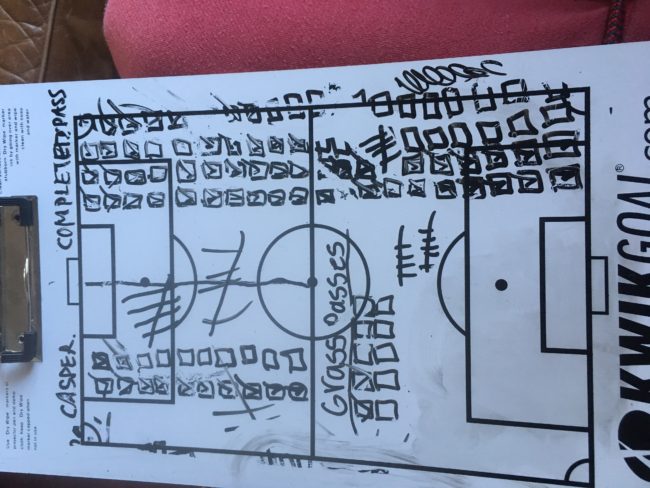09.18.18GUEST POST: Ruth Brennan Morrey on Teaching Players to Observe

Learning to understand the game (and watch out for Casper)
Teaching players to see and understand what’s happening around them is a critical issue in coaching–especially in soccer. It’s something I’m writing about in an upcoming book on the topic and it’s something I’ve tried to share other coaches‘ ideas about, especially the idea that some of the work of building perception can happen in what’s otherwise ‘downtime’ for players.
With that in mind I was inspired to see a recent tweet from Ruth Brennan Morrey, who coaches U12 girls in Rochester, MN and is a volunteer assistant for the St. Mary’s University women’s team–not to mention a former Div 1/semi-pro soccer player turned professional triathlete and PhD in psychology. In her tweet, Ruth described some of the things she’s been doing to help develop her players’ perception and understanding. I emailed her to ask for more detail and this post is an abridgement of the (many) insights she shared. She writes:
I listened to your latest podcast with Dan Abrahams and used several things on the weekend as our team prepared for two games. On the podcast you said something like…”Its important for coaches to not just understand what players are doing, but what they are seeing.”
I agree. Thinking, understanding, and SEEING the right things (e.g. space, opportunity, anticipation), before the DO is a fascinating, and puzzling concept to teach. The elites and professionals “do” BECAUSE they ‘see’. That’s the difference.
I realized that the bench is a perfect place to practice this skill.
I knew our second game of the weekend was going to be easier, so instead of “winning” as an objective, I tried to focus my players on aiming for strong decision-making and composure with the ball.
Playing a weaker team is often tough, because the intensity and physical play tends to be lower and the tendency is to play ‘down’ a level. At practice and at the game’s halftime, we briefly broke down what it takes to complete a pass (etc. a well paced pass to feet (‘blessing ball’), good support angle of receiver, tight first touch by receiver, two way communication).
I combined this with some other key ideas: anticipating errors, data collection, and keeping the bench mentally ‘locked in’. Instead of the assistant coach or me collecting game data, I had the resting players huddle around the clipboard together and watch for two specific things 1) Casper balls*, and 2) Completed passes.
[* A Casper ball is a pass that goes directly to a defender in the passing lane. I told my girls, “We can’t successfully complete a pass by kicking the ball through someone unless the defender is Casper the Friendly Ghost, so let’s settle the ball, stay composed, and find alternative passes.” That really clicked for them, so from then on, passing a ball to a defender became known as a “Casper” ball.]
Obviously, hitting Casper balls is usually a lack of passer composure, evidence of poor angles of support, perhaps some anxiety/lack of emotional control, and reactive behavior instead of intentional thought….so this is what we teach to avoid making Caspers. It is also a playful way to describe a common phenomenon that can be frustrating to players and coaches :-).
I have attached the clipboard pic from the game.

Our subbing rotation was regular, and all players had the opportunity to be students on the bench and quietly made their observations and charted the passes.
My observations:
- Once we labeled the “Casper ball,’ there were fewer Casper errors…almost immediately.
- The more the game progressed, the more successful the collective team became at completing passes. The girls improved their patience and composure, and improved on cutting out Caspers.
- Their critical eye became their own teacher and learning tool when it was their turn with the ball on the field.
Today at practice, I reviewed the assignment and told the team that hearing their critical thinking was my favorite part of the entire game.
I told them that I listened to the opposing team’s bench as well, and I heard comments like “Oh, I’m glad we don’t have practice tomorrow.” or “Are you going to the carnival next Friday.” or simply “good job” was not growing the players.
Passive, non-learners are missing the critical moments to learn and SEE!
